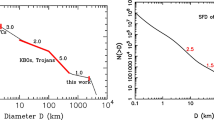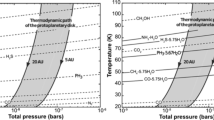Abstract
We present a review of the main physical features of comet nuclei, their birthplaces and the dynamical processes that allow some of them to reach the Sun’s neighborhood and become potentially detectable. Comets are thought to be the most primitive bodies of the solar system although some processing—for instance, melting water ice in their interiors and collisional fragmentation and reaccumulation—could have occurred after formation to alter their primordial nature. Their estimated low densities (a few tenths g cm−3) point to a very fluffy, porous structure, while their composition rich in water ice and other highly volatile ices point to a formation in the region of the Jovian planets, or the trans-neptunian region. The main reservoir of long-period comets is the Oort cloud, whose visible radius is ∼3.3×104 AU. Yet, the existence of a dense inner core cannot be ruled out, a possibility that would have been greatly favored if the solar system formed in a dense galactic environment. The trans-neptunian object Sedna might be the first discovered member that belongs to such a core. The trans-neptunian population is the main source of Jupiter family comets, and may be responsible for a large renovation of the Oort cloud population.
Similar content being viewed by others
References
F.C. Adams, E.V. Proszkow, M. Fatuzzo, P.C. Myers, Astrophys. J. 641, 504 (2006)
A. Bar-Nun, I. Kleinfeld, Icarus 80, 243 (1989)
G.M. Bernstein, D.E. Trilling, R.L. Allen, M.E. Brown, M. Holman, R. Malhotra, Astron. J. 128, 1364 (2004)
L. Biermann, in Astronomical Papers Dedicated to Bengt Stromgren, ed. by A. Reiz, T. Anderson (Copenhagen Observatory, 1978), p. 327
L. Blitz, in Protostars and Planets III, ed. by E.H. Levy, J.I. Lunine (Univ. Arizona Press, Tucson, 1993), p. 125
R. Brasser, M.J. Duncan, H.F. Levison, Icarus 184, 59 (2006)
M.E. Brown, C. Trujillo, D. Rabinowitz, Astrophys. J. 617, 645 (2004)
S. Charnoz, A. Morbidelli, Icarus 166, 141 (2003)
S. Charnoz, A. Morbidelli, Icarus 188, 468 (2007)
B.J.R. Davidsson, P.J. Gutiérrez, Icarus 168, 392 (2004)
B.J.R. Davidsson, P.J. Gutiérrez, Icarus 176, 453 (2005)
B.J.R. Davidsson, P.J. Gutiérrez, Icarus 180, 224 (2006)
A.H. Delsemme, Astron. Astrophys. 187, 913 (1987)
A.H. Delsemme, P. Swings, Ann. Astrophys. 15, 1 (1952)
B. Donn, Astron. Astrophys. 235, 441 (1990)
M.J. Duncan, H.F. Levison, Science 276, 1670 (1997)
M. Duncan, T. Quinn, S. Tremaine, Astrophys. J. Lett. 328, L69 (1988)
J.A. Fernández, Mon. Not. R. Astr. Soc. 192, 481 (1980)
J.A. Fernández, Astron. Astrophys. 96, 26 (1981)
J.A. Fernández, Icarus 129, 106 (1997)
J.A. Fernández, Comets. Nature, Dynamics, Origin, and their Cosmogonic Relevance (Springer, Dordrecht, 2005)
J.A. Fernández, A. Brunini, Icarus 145, 580 (2000)
J.A. Fernández, T. Gallardo, A. Brunini, Icarus 172, 372 (2004)
J.A. Fernández, W.-H. Ip, Planet. Space Sci. 44, 431 (1996)
J.A. Fernández, G. Tancredi, H. Rickman, J. Licandro, Astron. Astrophys. 352, 327 (1999)
P.J. Francis, Astrophys. J. 635, 1348 (2005)
P. Goldreich, W.R. Ward, Astrophs. J. 183, 1051 (1973)
R.S. Gomes, T. Gallardo, J.A. Fernández, A. Brunini, Celest. Mech. Dyn. Astron. 91, 109 (2005)
R. Greenberg, S.J. Weidenschilling, C.R. Chapman, D.R. Davis, Icarus 59, 87 (1984)
J. Heisler, S. Tremaine, Icarus 65, 13 (1986)
J.G. Hills, Astron. J. 86, 1730 (1981)
J. Holmberg, C. Flynn, Mon. Not. R. Astr. Soc. 313, 209 (2000)
H.H. Hsieh, D. Jewitt, Science 312, 561 (2006)
D. Jewitt, L. Chizmadia, R. Grimm, D. Prialnik, in Protostars and Planets V, ed. by B. Reipurth, D. Jewitt, K. Keil (Univ. Arizona Press, Tucson, 2007, in press)
V.A. Krasnopolsky, M.J. Mumma, M. Abbott, B.C. Flynn, K.J. Meech, D.K. Yeomans, P.D. Feldman, C.B. Cosmovici, Science 277, 1488 (1997)
P. Lacerda, D.C. Jewitt, Astron. J. 133, 1393 (2007)
E.A. Lada, K.M. Strom, P.C. Myers, in Protostars and Planets III, ed. by E.H. Levy, J.I. Lunine (Univ. Arizona Press, Tucson, 1993), p. 245
H.F. Levison, M.J. Duncan, Icarus 127, 13 (1997)
J. Luu, B.G. Marsden, D. Jewitt, C.A. Trujillo, C.W. Hergenrother, J. Chen, W.B. Offutt, Nature 387, 573 (1997)
F. Marchis, D. Hestroffer, P. Descamps, J. Berthier, A.H. Bouchez, R.D. Campbell, J.C.Y. Chin, M.A. van Dam, S.K. Hartman, E.M. Johansson, R.E. Lafon, D. Le Mignant, I. de Pater, P.J. Stomski, D.M. Summers, F. Vachier, P.L. Wizinovich, M.H. Wong, Nature 439, 565 (2006)
B.G. Marsden, G.V. Williams, Catalogue of Cometary Orbits, 16th edn. (Smithsonian Astrophysical Observatory, Cambridge, 2005)
W.M. Napier, S.V.M. Clube, Nature 282, 455 (1979)
J.H. Oort, Bull. Astr. Inst. Neth. 11, 91 (1950)
J.-M. Petit, M.J. Holman, B.J. Gladman, J.J. Kavelaars, H. Scholl, Mon. Not. R. Astr. Soc. 365, 429 (2006)
M. Podolak, D. Prialnik, in Comets and the Origin and Evolution of Life, ed. by P.J. Thomas, C.F. Chyba, C.P. McKay (Springer, New York, 1997), p. 259
A. Porras, M. Christopher, L. Allen, J. Di Francesco, T. Megeath, P.C. Myers, Astron. J. 126, 1916 (2003)
J.E. Richardson, H.J. Melosh, Lunar and Planetary Institute, XXXVII, Abstract No. 1836, 2006
D.D. Sasselov, M. Lecar, Astrophys. J. 528, 995 (2000)
C. Snodgrass, S.C. Lowry, A. Fitzsimmons, Mon. Not. R. Astr. Soc. 373, 1590 (2006)
S.A. Stern, Astron. J. 112, 1203 (1996)
S.A. Stern, P.R. Weissman, Nature 401, 589 (2001)
S.E. Strom, Rev. Mex. Astron. Astrof. 1, 317 (1995)
C.A. Trujillo, D.C. Jewitt, J.X. Luu, Astron. J. 122, 457 (2001)
E.F. van Dishoeck, G.A. Blake, B.T. Draine, J.I. Lunine, in Protostars and Planets III, ed. by E.H. Levy, J.I. Lunine (Univ. Arizona Press, Tucson, 1993), p. 163
M.K. Wallis, Nature 284, 431 (1980)
P.R. Weissman, Nature 320, 242 (1986)
Author information
Authors and Affiliations
Corresponding author
Rights and permissions
About this article
Cite this article
Fernández, J.A. Origin of Comet Nuclei and Dynamics. Space Sci Rev 138, 27–42 (2008). https://doi.org/10.1007/s11214-007-9274-3
Received:
Accepted:
Published:
Issue Date:
DOI: https://doi.org/10.1007/s11214-007-9274-3




